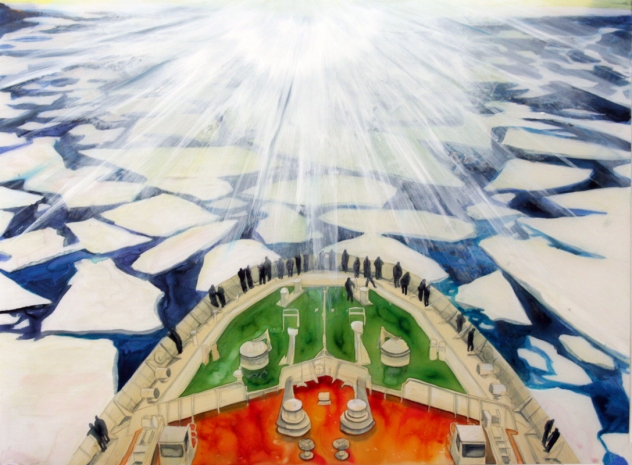NextNew:Green Review by M. Gant, Bohemian.com
Green Scenes
Artists take on environmental themes in ‘NextNew: Green’ show at the San Jose Institute of Contemporary Art
By Michael S. Gant
RECENTLY, I read a sci-fi novel about the usual hardy band of survivors picking up the pieces after a world-winnowing disaster—something along the lines of swine flu. The story included a number of au courant asides about man’s ecological mistakes, so I figured it must have been written in the last decade or so. Then I came upon a reference to Charlie McCarthy and Edgar Bergen. Turns out that the novel, Earth Abides, was written by UC-Berkeley English professor George R. Stewart—in 1949.
For at least 60 years then, artists have been worrying about what we’re doing to the planet, and politicians have been pretty much ignoring them. “NextNew: Green,” at the San Jose Institute of Contemporary Art, highlights the work of some young artists, just out of MFA programs, trying to make us sit up and pay attention, if not take action. Some of the pieces are provocative, but I worry that they have as much effect on our response to global warming and climate change as antiwar films have on war.
The general tone is dystopian. Misako Inaoka contributes small mutant hybrid animals, both mounted on wooden plaques as trophies and arrayed on a chess board. Cobbled together from children’s toys and painted silver, the menagerie depicts a scary future of desperate adaptation: a bird with horse haunches for a tail, a moose burdened with bird-claw antlers, a shark/walrus mix-up walking on gorilla legs. One of these clever, cautionary beasts even chirps and swivels its head in responds to a viewer’s attention. Call them Darwin’s worst nightmares.
Ryan Pierce’s oil Down by the Riverside, with its flat, patterned river flowing through a wasted landscape of clear-cut tree stumps and wooden crosses, reminds me of Chester Arnold’s Road to Paradise. The Arnold, which showed at last year’s “Eureka!” group exhibit at SJICA, depicted a once-pristine rivulet choked with society’s detritus. Something about a wilderness makes us want to despoil it, apparently.
The whole sorry process of civilization gets laid bare in Carson Murdach’s series of unframed paintings done in a faux-19th-century folk-art style. In large canvases, the colonizing ships arrive in an armada at an Edenic shore; a settlement sprouts; a great city full of monumental buildings from across history chokes out the natural landscape. In the final, smaller panels, after some unspecified disaster, ships loaded down with little red-roofed houses, fight stormy waves as they beat a hasty retreat.
Michelle Blade’s large ink paintings use ships to a more mystical purpose. In Facing an Abyssal Sea, vessels of all sizes converge on a horizon illuminated by a glowing orb. It’s hard to escape the thought that we are witnessing a world submerged, with the remnants of sea-borne humanity drawn lemming fashion to a final rendezvous. Untitled (We Found God on a Cruise Ship) shows passengers crowded on the prow of a ship headed through ice floes toward shimmering, almost blinding rays of light. Here the unbearable lightness of icebergs (or what’s left of them) exerts the same sense of sublime awe that it did on the great landscape painter Frederic Church.
Several of the “NextNew” artists deploy cast-off materials: recycling as a kind of redemption. Vanessa Marsh’s sculptures of industrial wreckage—a cement factory, a deserted segment of freeway—are meticulously fashioned from various found materials. The modeler in me admires the exquisite craft, but they do not transcend the scenic achievements that can be found at a toy-train convention.
More effective are Sandra Ono’s soft sculptures made from hundreds of balloons scrunched together at the necks to make lumpy shapes both beautiful and sinister—Untitled (Black Balloons) could be a thick bubble of tarry residue seeping from a superfund site.
Most troubling is Michael Ryan’s installation Dead Space, which uses motors, wires and tubes to animate some plastic bags that seem to respire gently with rhythmic puffs of air. It’s like an abstracted Frankenstein’s monster constructed not from body parts but consumer packaging.
NEXT NEW: GREEN runs through Sept. 20 at the San Jose Institute of Contemporary Art, 560 S. First St., San Jose. Tuesday–Friday, 10am–5pm, Saturday noon–5pm. Free. (408.283.8155)







Reply